Bear in mind that all 16 valve engines tend to have a rougher idle than their 8 valve brethren. Also the ECU on the Morgan Zetec prioritizes low emissions over good performance so even on a perfect car, there will be some unevenness of idle as the ECU searches for the very lowest emissions. When it occasionally goes too far, it must increase the revs to compensate.
Although the list here is large and growing, do not assume
the Zetec engine is fault-ridden.
| Poor idle when warm | Vacuum Leak
Crankcase Breather Valve Plenum Leaks Pulse Air Injection Pulse Air Injection Solenoid |
| Poor idle when cold | Vacuum Leak
Wrong Oil |
| High hanging rev (normally when cold) | Throttle Body Resonance |
| Poor idle at all times | Vacuum Leak
HT Leads Spark Plugs Rubber T Piece Idle Speed Control Valve Auxiliary Drive Belt pulleys EGR Valve Lambda Sensor |
| Poor idle at some times | Vacuum Leak
EGPD valve HT Leads Spark Plugs Inlet Air Temperature Sensor EGR Solenoid Heat Soak Throttle Body Gasket Throttle Body Position Sensor |
| Bad idle and stalling when warm | Loose Eprom |
The Zetec produces a very powerful (and reliable) wasted spark from the capacitor discharge coil. But due to the large plug gap Ford specifies, the current must be very strong to create a good spark at the plugs. This puts a lot of stress on the HT leads and they often fail. Don't replace them with a cheap set..buy quality. Ford or Splitfires are suggested. Bosch, Halfords are not.
Be careful when removing leads. always rotate the lead to break the suction and stickiness before pulling the boot firmly. Never pull the lead. Always change plugs and leads as a set as a problem in one can damage the other
To remove, stick your hand under the coil (towards the rear about 5cm below the coil base). Feel for the rubber bit and pull firmly. It takes about 20 seconds to swap it.
On my coil, the t- piece connects the thick silver tube on the lower left to the thin tube to the right of the coil, and the third way goes to the engine block. It just pulls off
It is part 8A on the diagram.
 EGPD
Valve
EGPD
ValveWhen it malfunctions, it switches the EGR valve in and out when it shouldn't, resulting in a lower crankcase vacuum
The EGPD Valve is the silver box on the right. Also check
the rubber vacuum lines running to it for cracks or splits.
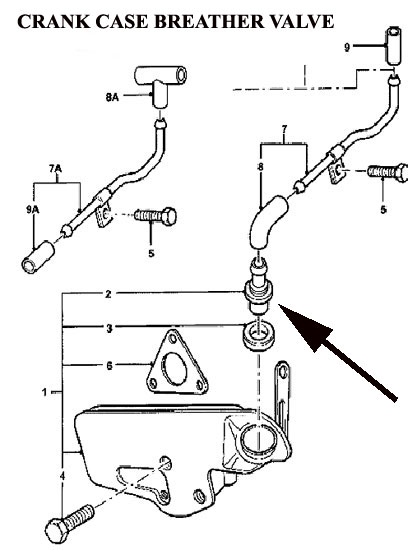 The
Crankcase Breather Valve (Positive Pressure Valve)
The
Crankcase Breather Valve (Positive Pressure Valve)Ford says that it should be changed at 30,000 mile intervals but then they forget to mention that in their service guides and Haynes forgets it entirely. I am told it is very difficult to change. Symptoms of blockage are a decent idle when cold, which gets worse as the engine warms and then leads to complete stalling at working temps. The engine seems to pulse and hunt with a one second frequency between 1500 and 700 rpm
The arrow points to the rubber tube running to it. To change it, remove the rubber T piece under the coil. Reach under the thermostat housing and you will find a small T3 (sometimes T4) bolt holding the metal pipe on. Remove this. Now reach your hand in under the pulse air piping and give the rubber tube a good pull (Pliers help) and the valve should pull out. Use some sealant as you replace it, as the rubber grommet it sits on can be very brittle and hard.
There are many vacuum lines around the Zetec engine. The plenum chambers can also chafe vacuum lines. Alternatively, you can also use a vacuum gauge and test. You should have a nice steady 17-20 psi vacuum at idle. Cure the leaks, cure your idle.
Look here under plenum leaks.
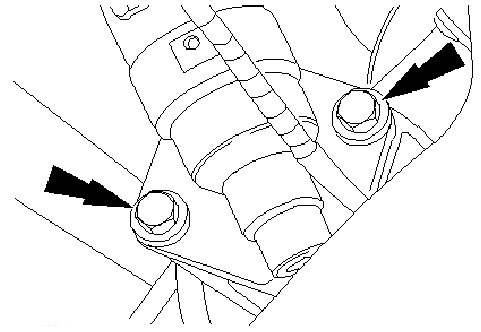 Idle
Speed Control valve
Idle
Speed Control valveThe valve can be removed with the plenum is off, but is awkwardly placed and you will need the right socket extension. Stick your hand in under the TB and intake manifold. There are 2 bolts holding it on.
Its situated under the black inlet manifold and you will
not be able to see it so you must remove it by feel. DO NOT drop the bolts
either and MAKE SURE sure the gasket is intact when you replace it. New
units come with a new gasket.

To test, use a multimeter and while watching the resistance, gently rotate the inner spindle (don't force it), you should get a nice gentle sweep of resistance. Any spike or anomaly's and its dead. Unfortunately the place its most likely to wear is the idle position which is hard to test. You can wash the inside out with WD-40 as a precaution. A new one is £25.
When refitting make sure the rubber seal on the throttle body is intact and flat. There have been problems with this seal distorting and sitting the potentiometer at an angle which forces it to give erroneous readings.
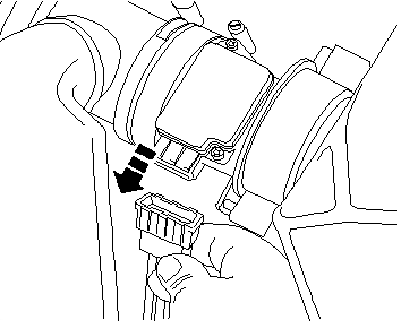 MAF
MAFWhen removing the MAF, make sure you don't pull on the wires, but gently hold the plug
There was a big problem with early cars as plug contacts
and MAF are alloy and corrode, prejudicing the contact. Ford now makes
these using gold contacts. They also have a kit for converting the old
connectors to the gold contact one (with lots of soldering). When you reconnect
make sure that it really is firmly in and that none of the wires are broken.
Its worth disconnecting and replugging this every now and then to ensure
the contacts are clean and making contact. A new MAF is £80. A good
one makes a huge difference to the performance. Symptoms of a bad MAF are
a slightly rough idle and low power.
 Lambda
O2 Sensor
Lambda
O2 SensorN.B. The sensor does not operate until it has reached its working temperature.
Lambda sensors last about 80-100k miles before they die. A dead one generally gives all sorts of running problems and lack of power including a bad idle when warm. (Not when cold). You can check the voltage from it properly only with an oscilloscope as it pulses its signal. So either swap it out or go to a garage for testing. Make sure you don't touch the tip of the probe or you will contaminate it. Later Zetecs have two, one per exhaust.
This is another common problem with the 1.8 Zetecs. It
is a manufacturers' defect and the subject of a Ford recall;
| Model: Focus with 2.0L Zetec-E engine
with MTX 75 transmission built from 11.1999 to 07.2000 (build codes XM
to YD)
Markets: All Subject: Intermittent high idle or idle hang up (above 2000 rev/min) with/without moose noise Summary Should a customer express concern about intermittent high idle or idle hang up between 2000-4000 rev/min with or without a moose noise mainly when coming to a stop, the probable cause is acoustic resonance of the inlet air control (IAC) system. This concern should be rectified by installing a new intake manifold, distributor vacuum hose and crankcase vacuum hose. Production Action A revised intake manifold has been installed in production since 08.2000 (build code YE). Also look HERE |
The defective components should have been replaced by your Morgan dealer, claimed against the Company and they will claim from Ford.. However, I have heard that the MMC refuses these claims beyond the warranty period. Ford did not.
It has also been reported that a European Morgan dealer found a cure without, apparently, (from the forum emails) understanding the cause. He fit a metal spacer into the throttle body. This extra hunk of aluminum apparently dampens the resonance to allow smooth running at idle (but with unknown effect on performance otherwise).
Sadly, some owners have also used restrictor plates to stop full airflow and that too will stop the resonance..at a very deep cost to performance. The best solution is to fit a new intake manifold, distributor vacuum hose and crankcase vacuum hose made as directed by Ford.
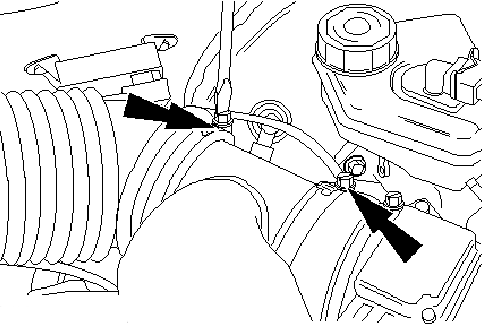
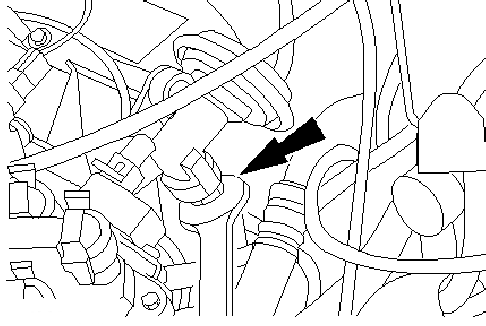
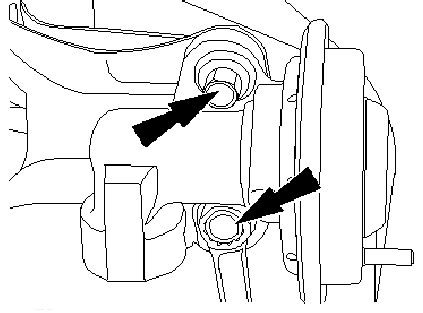 EGR
Valve
EGR
ValveThe EGR valve is controlled by its solenoid and the EGPD valve. If it activates at the wrong time it will decrease performance and hurt idle. It can also physically fail which results in a vacuum leak. Remove the old valve and clean it with throttle body cleaner. Check if its diaphragm is intact. To tell if it is working remove its vacuum line from the other end and suck hard. It should stall out a running engine or make it run very poorly.
In time, the diaphragm will fail. Their cost is £50 and they are easy to fit. Unscrew the nut underneath it and remove the two bolts. No need to move or loosen the pipe running into the bottom.
 EGR
Solenoid
EGR
Solenoid When
it is defective you will hear a loud clacking noise that sounds like valve
rattle. There is a foam filter in the black plastic box which can be cleaned.
You can take the black plastic box from the pipe work and clean it. But
that will probably not help. Fitting a new unit will.
When
it is defective you will hear a loud clacking noise that sounds like valve
rattle. There is a foam filter in the black plastic box which can be cleaned.
You can take the black plastic box from the pipe work and clean it. But
that will probably not help. Fitting a new unit will.
The pulse air injection unit is sold as a single assembly
for £200, including the valve box and new tubing. You can do the
swap with the exhaust in place. You can see the silver piping and the top
of the valve box in the image. .
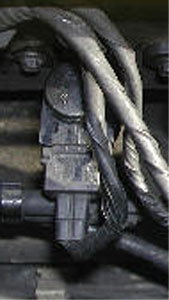 Pulse
Air Injection Solenoid
Pulse
Air Injection SolenoidTo test, go under the front of the car and remove the vacuum line from the pulse air injection system black box. Connect a vacuum gauge. You should get vacuum only on a cold engine and overrun. If there is any vacuum at idle on a hot engine then the solenoid is broken. Replacement is £31 and just the two screws hold it on. A very rough idle to stalling are the symptoms
Use Mobil 1. The best prevention is to use the correct grade oil. Ford say that you should use a min of 5W winter rated oil (so 10W is bad). If you have put in the wrong oil or don't know what is in there then do an oil change using a synthetic 5W-30 oil, leave this in for a couple of weeks to spread round and dissolve/pick up the gunk and then change again to your main oil Do not forget to change the oil filters whenever you change the oil
4/4 Ford 1800cc Zetec ECU: Problem
and Fix Explained.
by Philip Young
PROBLEM
You would be driving along at 70 + and the engine would suddenly start cutting in and out. Drive along for a few more miles and then the engine would cut out completely. Wait about 2 minutes without doing anything, restart the engine and everything would be fine. Initially this would only happen once in a while but eventually it happened on a regular basis. So I took the car to EFI expert and all the sensors on the engine were checked and all were fine. Of course, the engine never evidenced a problem whilst been checked.
In spite of all this checking, the final straw was when the engine cut out three times on the way home from Shrewsbury during July 2000. The next evening I sat down and analyzed the thing. I was convinced that there was nothing wrong with the sensors. The only thing that remained to be checked was the ECU, I knew that the previous owner had changed the EPROM on the ECU many times. The next evening I removed the ECU from the car and dismantled it, I removed the EPROM that is only secured with sticky tape and is a push fit on the ECU printed circuit board. The EPROM turned out to be extremely loose.
FIX
With a soldering iron (and making sure that you are wearing an earth/ground strap so that you do not damage the ECU PCB components) carefully re-tin all of the EPROM contacts with solder. The PCB is double sided so the contacts on both sides of the PCB have to be tined. Re-assemble the ECU, refit the EPROM and now you will find it is a very tight fit. Secure the EPROM with new sticky tape ( I used tank tape). Fit the ECU back into the car and start the engine. Since I did this, I have had no problems with my engine on this score.